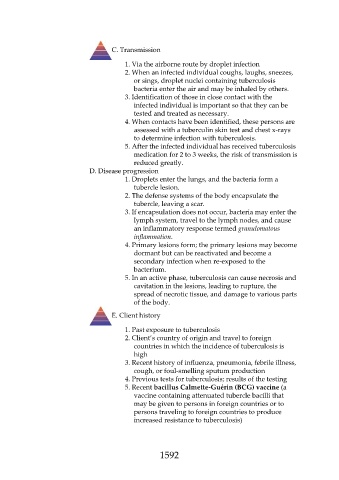Page 1592 - Saunders Comprehensive Review For NCLEX-RN
P. 1592
C. Transmission
1. Via the airborne route by droplet infection
2. When an infected individual coughs, laughs, sneezes,
or sings, droplet nuclei containing tuberculosis
bacteria enter the air and may be inhaled by others.
3. Identification of those in close contact with the
infected individual is important so that they can be
tested and treated as necessary.
4. When contacts have been identified, these persons are
assessed with a tuberculin skin test and chest x-rays
to determine infection with tuberculosis.
5. After the infected individual has received tuberculosis
medication for 2 to 3 weeks, the risk of transmission is
reduced greatly.
D. Disease progression
1. Droplets enter the lungs, and the bacteria form a
tubercle lesion.
2. The defense systems of the body encapsulate the
tubercle, leaving a scar.
3. If encapsulation does not occur, bacteria may enter the
lymph system, travel to the lymph nodes, and cause
an inflammatory response termed granulomatous
inflammation.
4. Primary lesions form; the primary lesions may become
dormant but can be reactivated and become a
secondary infection when re-exposed to the
bacterium.
5. In an active phase, tuberculosis can cause necrosis and
cavitation in the lesions, leading to rupture, the
spread of necrotic tissue, and damage to various parts
of the body.
E. Client history
1. Past exposure to tuberculosis
2. Client’s country of origin and travel to foreign
countries in which the incidence of tuberculosis is
high
3. Recent history of influenza, pneumonia, febrile illness,
cough, or foul-smelling sputum production
4. Previous tests for tuberculosis; results of the testing
5. Recent bacillus Calmette-Guérin (BCG) vaccine (a
vaccine containing attenuated tubercle bacilli that
may be given to persons in foreign countries or to
persons traveling to foreign countries to produce
increased resistance to tuberculosis)
1592

